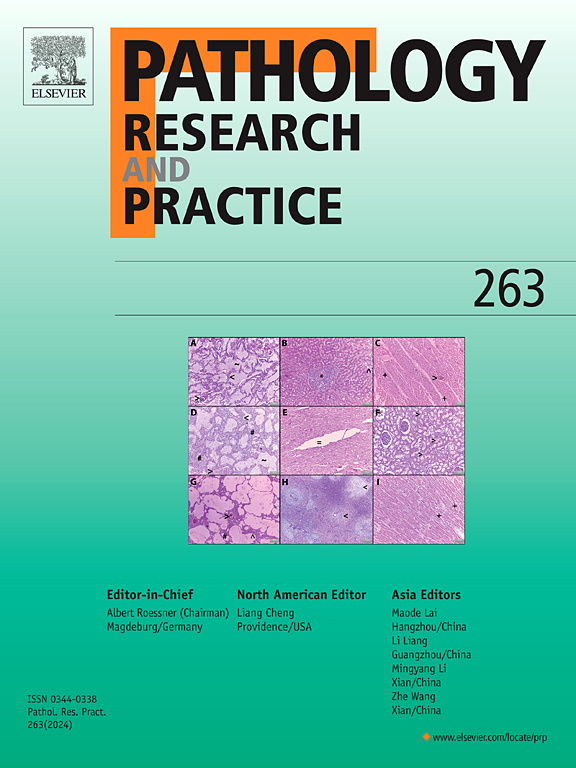缺乏smarca4的非小细胞肺癌的临床病理特征
IF 3.2
4区 医学
Q2 PATHOLOGY
引用次数: 0
摘要
smarca4缺陷型非小细胞肺癌(SMARCA4-dNSCLC)是一种预后差的低分化肿瘤。目前关于该类肿瘤的分子特征报道较少,探索SMARCA4-dNSCLC的临床病理特征对其预后和治疗方案的研究至关重要。方法采用免疫组化(IHC)技术检测9例患者外周血中CK、Vimentin、CK7、TTF-1、Napsin-A、P40、CK5/6、Syn、CD34、small -4、SOX2、BRG-1、ni -1、PD-L1、Ki-67的表达。应用基于dna的肿瘤相关突变新一代测序(NGS)技术检测6例患者的相关分子特征。结果9例患者中,男8例,女1例;6例有长期吸烟史(10-60年,3-40支/天);6例出现淋巴结或骨转移。对于IHC, CK7在所有病例中均呈强阳性。CD34均为阴性。BRG-1始终不存在。i -1在任何情况下都没有丢失。Napsin-A和P40在1/9的病例中呈阳性。Vimentin、TTF-1、Syn阳性2/9。CK5/6、small -4、SOX-2部分阳性3/9。PD-L1表达呈异质性分布,33.3% %(3/9)为阴性表达,55.6% %(5/9)为低表达,11.1 %(1/9)为高表达。Ki-67增殖指数为20 % ~ 90 %。6例接受基因检测的患者中,4例(4/6)检测到SMARCA4基因突变,6例(6/6)均检测到TP53基因突变。4例(4/6)患者检测到LRP1B基因改变,3例(3/6)患者检测到KEAP1基因改变。2例(2/6)患者发现STK11基因改变,1例(1/6)患者发现EGFR基因突变。6例患者均未出现KRAS、ROS或ALK基因的遗传变化。肿瘤突变负荷(TMB)低频率3例,高频率3例。结论本研究分析了9例SMARCA4-dNSCLC的临床病理特征和免疫组织化学特征,并对其中6例进行了新一代测序,初步探讨了该肿瘤类型的分子遗传改变。本研究结果对临床病理诊断及治疗策略制定具有参考价值。然而,由于样本量小、随访时间较短等局限性,本研究的结论需要通过更大规模的队列研究来验证。未来的工作将集中于扩大样本量,延长随访时间,并启动多中心合作,以进一步阐明该疾病的临床病理和分子特征。本文章由计算机程序翻译,如有差异,请以英文原文为准。
Clinicopathological features of SMARCA4-deficient non-small cell lung cancer
Background
SMARCA4-deficient non-small cell lung cancer (SMARCA4-dNSCLC) is a poorly differentiated tumor with dismal prognosis. Currently, there are few molecular features reported on this type of tumor, and exploring the clinico-pathological features of SMARCA4-dNSCLC is crucial for prognosis and investigating treatment options.
Methods
Immunohistochemistry (IHC) was used to detect the expression of CK, Vimentin, CK7, TTF-1, Napsin-A, P40, CK5/6, Syn, CD34, SALL-4, SOX2, BRG-1, INI-1, PD-L1, and Ki-67 in 9 patients. DNA-based Next-generation sequencing (NGS) technology for tumor-related mutations was applied to detect the relevant molecular characteristics in 6 patients.
Results
Among the 9 patients, 8 were male and 1 was female; 6 had a long-term smoking history (10–60 years, 3–40 cigarettes/day); 6 presented with lymph node or bone metastases. For IHC, CK7 was strong positive in all cases. CD34 was negative in all. BRG-1 was consistently absent. INI-1 was not lost in any case. Napsin-A and P40 were positive in 1/9 cases. Vimentin, TTF-1, and Syn were positive in 2/9 cases. CK5/6, SALL-4, and SOX-2 were partially positive in 3/9 cases. PD-L1 expression demonstrated heterogeneous distribution: 33.3 % (3/9) of cases showed negative expression, 55.6 % (5/9) exhibited low expression, and 11.1 % (1/9) demonstrated high expression. and the Ki-67 proliferation index ranged from 20 % to 90 %. Among the 6 patients who underwent genetic testing, SMARCA4 gene mutations were detected in 4 cases (4/6), while TP53 gene mutations were present in all 6 cases (6/6). Genetic alterations in LRP1B were observed in 4 patients (4/6), and KEAP1 gene changes were identified in 3 cases (3/6). STK11 gene alterations were found in 2 patients (2/6), whereas EGFR gene mutation was only detected in 1 case (1/6). None of the 6 patients showed genetic changes in KRAS, ROS, or ALK genes. Regarding tumor mutational burden (TMB), 3 cases demonstrated low TMB frequency while the other 3 exhibited high TMB.
Conclusion
This study analyzed the clinicopathological characteristics and immunohistochemical profiles of 9 cases of SMARCA4-dNSCLC, and performed next-generation sequencing on 6 of these cases to preliminarily investigate the molecular genetic alterations in this tumor type. The findings provide reference value for clinicopathological diagnosis and treatment strategy formulation. However, due to limitations including the small sample size and relatively short follow-up period, the conclusions of this study require validation through larger cohort studies. Future work will focus on expanding the sample size, extending follow-up duration, and initiating multicenter collaborations to further elucidate the clinicopathological and molecular characteristics of this disease.
求助全文
通过发布文献求助,成功后即可免费获取论文全文。
去求助
来源期刊
CiteScore
5.00
自引率
3.60%
发文量
405
审稿时长
24 days
期刊介绍:
Pathology, Research and Practice provides accessible coverage of the most recent developments across the entire field of pathology: Reviews focus on recent progress in pathology, while Comments look at interesting current problems and at hypotheses for future developments in pathology. Original Papers present novel findings on all aspects of general, anatomic and molecular pathology. Rapid Communications inform readers on preliminary findings that may be relevant for further studies and need to be communicated quickly. Teaching Cases look at new aspects or special diagnostic problems of diseases and at case reports relevant for the pathologist''s practice.

 求助内容:
求助内容: 应助结果提醒方式:
应助结果提醒方式:


